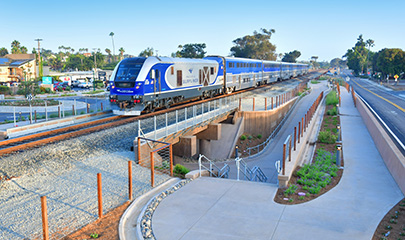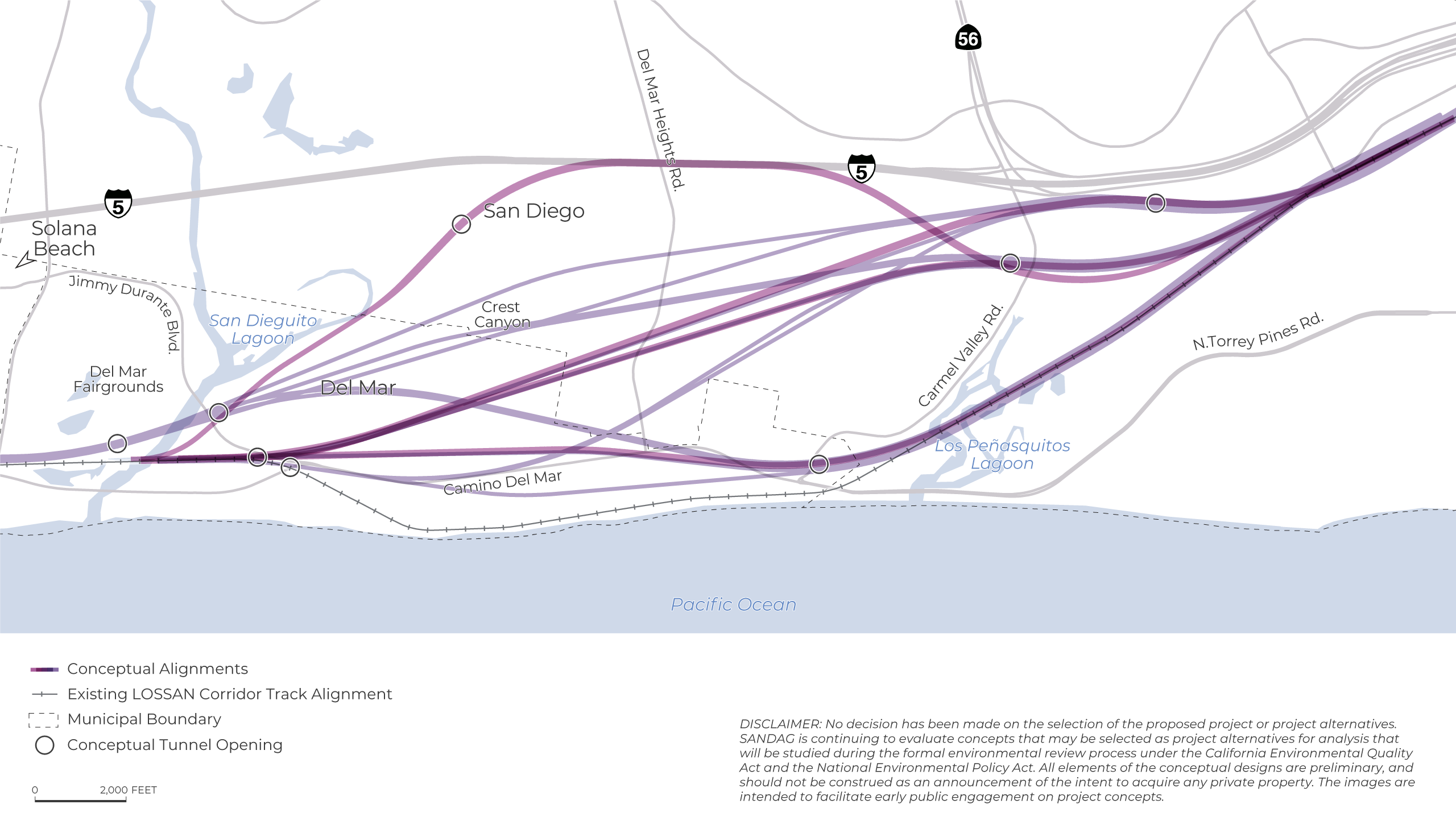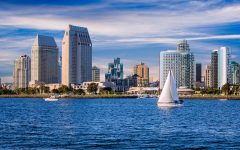
SANDAG - Del Mar Bluffs & LOSSAN Rail Improvements. (Photo: sandag.org)
Tunneling to Nowhere: Del Mar Train Proposals Raise Eyebrows
Councilmen has been asking SANDAG for the cost-benefit analysis for the tunnel project for over a year
By Thomas Buckley, January 2, 2024 6:56 am
The train tracks along the ocean in Del Mar are slipping and they have been for years.
The tracks in the San Clemente area of the same route – which carries freight and the Coaster and AMTRAK Surfliner trains – are slipping as well, leading to a pair of closures in 2023.
The erosion problem has faced the route – which hugs the coast – for years, even longer than people have been mooning the trains in Laguna Niguel.
While physically striking, the route south from Orange County to San Diego is not only in danger itself but a danger to passengers, transport experts say.
The question now is how to fix it, though some are wondering whether or not it makes financial sense to bother to fix it.
The Surfliner runs from San Luis Obispo to San Diego and carries about 1.6 million people a year (it averaged about 2.8 million pre-pandemic.) The Coaster, which runs from Oceanside to San Diego, carries about 750,000 people (it connects to the greater Los Angeles Metrolink system in Oceanside.).
That does sound like a lot of people, but in fact it works out to be only about 5,000 a day taking the trains between south Orange County and San Diego proper.
The cost to fix those tracks? By some estimates, about $4 billion for the Del Mar problem – which would involve tunnelling under the city for about two miles – and another $15 billion to take care of Orange County issues. In other words, the per passenger cost could be even higher than the ludicrous high speed rail project. (Note – it may not be necessary to point this out, but public rail projects are rarely “on budget.” I won’t even dignify the notion of “on time.”)
And that fact has at least one member of the Del Mar City Council wondering if the tracks need to be fixed at all.
“The cost per rider keeps going higher,” said Councilman Dan Quirk.
The tracks are controlled by the LOSSAN (Los Angeles – San Diego – San Luis Obispo) Rail Corridor Agency and used by AMTRAK, Metrolink, and the North County (San Diego) Transit District and other private and transit agencies. The Del Mar project falls under the planning purview of the San Diego Association of Governments (SANDAG,) an agency known for its very pro-public transit stance (and its’ staff’s attempt to push a vehicle miles traveled tax).
Quirk says SANDAG has not done a proper cost-benefit analysis of the project, in part because such a detailed look would not stand up to scrutiny.
“For over a year, I have been asking SANDAG for the cost-benefit analysis for the tunnel project,” Quirk said. “They have ignored my requests, delaying and dissembling.”
Quirk also has concerns about the funding mechanisms involved in both the Del Mar project and high speed rail, saying that “California is just trying to lie to get federal dollars,” adding that he hopes that there will be a formal investigation will be launched into the issue of high speed rail and other projects.
The issues being ignored by SANDAG include the possibility of alternatives that do not involve tunnelling under Del Mar, the actual community value of the train service, that the train carries less than one percent of the people than the parallel I-5, and the fact that transportation technology is improving at such a quick pace (driverless cars, for example) that trains in general are not good investments for the future. For example, the Del Mar project is expected to be finished in 2035 and the Orange County improvements will take even longer (both projects – though separate – are needed to fully improve the corridor.)
Other Del Mar residents have raised concerns about the impacts of tunneling under homes and businesses, from potential vibration issues to safety/derailment events.
As for shoring up the existing tracks, proponents and opponents both say that may be a non-starter as the state’s all-powerful Coastal Commission takes a very dim view of massive retainer walls and such (and many advocacy groups, and even many Del Mar residents, have been itching to get the tracks off the coast for years.)
SANDAG has produced a number of potential routes for the tunnel under Del Mar:

and says it will continue to take public input on the project.
What SANDAG, it appears, will not do is back away from the tunnel concept and seriously look at other options – such as using the I-15 corridor for above-ground tracks – as Quirk hopes.
“It is the primary passenger and freight corridor between LA and San Diego and the only option besides driving on the freeways,” said Colleen Clementson, SANDAG’s new CEO, officially replacing the controversial Hassan Ikhrata today.
“Every option has pros and cons, but we need the rails off of the bluffs,” Clementson said. “They’re crumbling and even our measures to stabilize them are not going to last forever.”
Besides the passenger traffic, the rail corridor carries freight (although a very small percentage of the freight that moves through southern California in total) from the Port of San Diego and is part of the Department of Defense’s Strategic Rail corridor program, connecting the port to Camp Pendleton.
In other words, preserving the corridor is vitally important, said Clementson, and the best way to do that is with the proposed tunnels.
Clementson said SANDAG is working with Orange County on the overall project, but the rail corridor is “only as strong as its weakest link.”
That weak link right now is unquestionably in Del Mar, though the question remains as to whether building a $2 billion-a-mile tunnel is the way to fix it.
- ADA Diana Teran Booked, Los Angeles DA Gascon Faces Another Complaint - April 28, 2024
- Curiouser and Curiouser: Gascon’s Aide Charges Raise Troubling Issues - April 27, 2024
- Reedley ‘Lab’ Prompts Legislation - April 26, 2024




